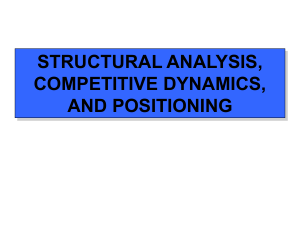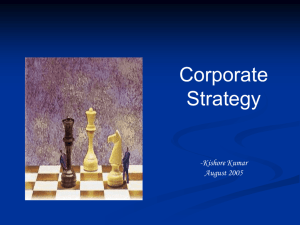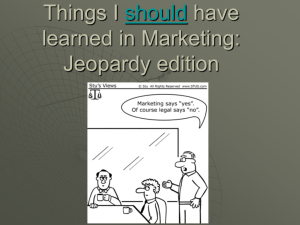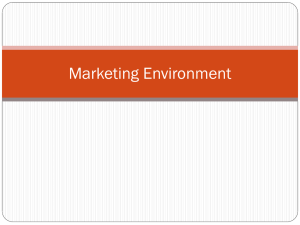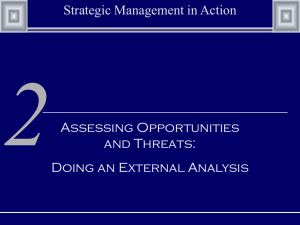Strategic Management: An Overview
advertisement
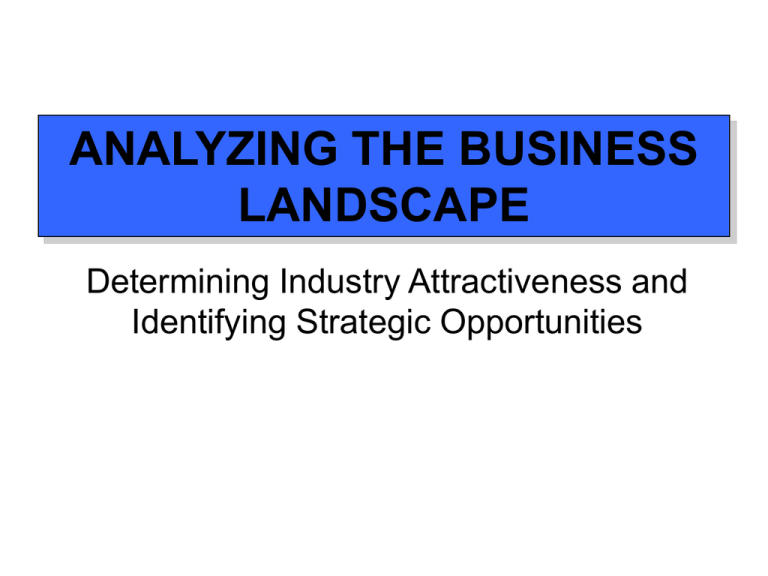
ANALYZING THE BUSINESS LANDSCAPE Determining Industry Attractiveness and Identifying Strategic Opportunities Distribution of Industry Returns Average Return on Equity in US Industries, 1982-1993 16.5% 90 13.8% 11.7% 100 80 First Quartile Average 22.2% Fourth Quartile Average 9.3% 70 Number 60 of 50 Industries 40 Average = 14.7% Median = 13.8% 30 20 10 0 32% Return on Equity = Net Income / Year End Shareholders’ Equity; Analysis based on sample of 593 industries 30% Note: 28% Source: Jan W. Rivkin’s Analysis Based on Dun and Bradstreet Data 26% 24% 22% 20% 18% 16% 14% 12% 10% 8% 6% 4% 2% Return on Equity (Percent) Profitability Differences Across Selected Industries Pharmaceuticals Prepackaged software Semiconductors Women's clothing stores Dental equipment Eating places Drug stores Petroleum / natural gas Race track operations Trucking except local Engineering services Computer system design Cable TV service Motor vehicles Scheduled airlines Source: Jan W. Rivkin based on Compustat 0 5 10 15 Operating Income / Assets, 1988-95 (%) 20 25 Critical Steps in Business Landscape Analyses Step 1: Analyze shocks and trends in the macro-environment Step 2: Analyze the nature of market demand and consumer behavior Step 3: Analyze business landscape (industry) - Five competitive forces Framework - Coopetition and Value Net Framework Step 4: Identify critical success factors Step 5: Analyze the intra-industry(strategic group) structure of the industry and identify critical differences between groups Step 6: Evaluate the competitive sustainability/ vulnerability of strategic positions of rivals Components Of The Macro Environment Demographic Economic Industry Environment Global Political/ Legal Competitive Environment Technological Sociocultural Analyzing Market Demand And Consumer Behavior • Identify market segments and the bases for inherent differences among customers • • • • • buyer characteristics and preferences price sensitivity and cross-price elasticities patterns of use receptivity to marketing etc. • Analyze aggregate and market segment growth rates, saturation levels, replacement-purchase rates, etc. • Estimate/forecast the “shape” of the demand curve for the industry and each segment, keeping in mind that there is, ex ante, no such thing as an industry life cycle. • Distinguish the nature of the products/services. i.e. observable goods, experience goods, communication effect goods Industry Analysis Analyzing the Competitive Structure and Behavior of Industries Porter’s Five Forces Analysis Threat of New Entry Bargaining Power of Suppliers • Differentiation of inputs • Switching costs • Presence of substitute inputs • Supplier concentration • Importance of volume to supplier • Cost relative to total purchases • Impact of inputs on cost or differentiation • Threat of forward integration • Economies of scale • Proprietary product differences • Brand identity • Switching costs • • • • • Capital requirements Access to distribution Absolute cost advantages Government policy Expected retaliation Rivalry Among Existing Competitors • Industry growth • Fixed costs / value added • Overcapacity • Product differences • Brand identity • • • • • • Switching costs Concentration and balance Informational complexity Diversity of competitors Corporate stakes Exit barriers Threat of Substitutes • Relative price performance of substitutes • Switching costs • Buyer propensity to substitute Source: Michael E. Porter, Competitive Advantage (New York: Free Press, 1985) Bargaining Power of Customers • • • • • • • • • • • Buyer concentration Buyer volume Buyer switching costs Buyer information Ability to integrate backward Substitute products Price / total purchases Product differences Brand identity Impact of quality / performance Buyer profits SUPPLIER POWER LOW THREAT OF ENTRY LOW •economies of scale •capital requirements for R&D and clinical trials •product differentiation •control of distribution channels •patent protection INDUSTRY COMPETITIVENESS LOW •high concentration •product differentiation •patent protection •steady demand growth •no cyclical fluctuations of demand BUYER POWER LOW Physician as buyer: Not price sensitive No bargaining power. (Changing with managed care.) DRUG INDUSTRY (ROE=28%) THREAT OF SUBSTITUTES LOW No substitutes. (Changing as managed care encourages generics.) SUPPLIER POWER HIGH •strong labor unions •concentrated aircraft makers THREAT OF ENTRY HIGH •entrants have cost advantages •low capital requirements •little product differentiation •deregulation of governmental barriers INDUSTRY COMPETITIVENESS HIGH •many companies •little product differentiation •excess capacity •high fixed/variable costs •cyclical fluctuations of demand BUYER POWER MEDIUM/HIGH Buyers extremely price sensitive Good access to information Low switching costs Airline Industry (ROE=-1%) THREAT OF SUBSTITUTES MEDIUM •autos for short distance travel Coopetition and the Value Net A player is your competitor with respect to customers if customers value your product less when they have the other player’s product as well Competitors A player is your competitor with respect to suppliers if it is less attractive for a supplier to provide resources to you when it is also supplying the other player Customers Firm Suppliers A player is your complementor with respect to customers if customers value your product more when they have the other player’s product as well Complementors A player is your complementor with respect to suppliers if it is more attractive for a supplier to provide resources to you when it is also supplying the other player Source: Adam Brandenburger and Barry Nalebuff, Co-operation (New York: Currency Doubleday, 1996) Neutralizing The Five Competitive Forces Force Entry Method for Neutralizing Force Erecting barriers (isolating mechanisms) create exploit economies of scale, aggressive deterrence, design in switching costs, etc. Rivalry Compete on nonprice dimensions: cost leadership, differentiation, cooperation, etc. Substitutes Buyers Improve attractiveness compared to substitutes: better service, more features, etc.. Reduce buyer uniqueness: forward integrate, differentiate product, new customers, etc.. Suppliers Reduce supplier uniqueness: backward integrate, obtain minority position, second source, etc.. Analyzing Intra-industry Heterogeneity Market Segmentation, Strategic Group and Competitor Analysis Strategic Group Analysis • A strategic group is a group of firms in an industry following the same or similar strategy • Identifying strategic groups: • Identify principal strategic variables which distinguish firms. For example, single product Vs product family, private labeling Vs branded products, push Vs pull marketing, etc. • Choose variables that produces the greatest contrast between firms, usually the CSFs. Do not use correlated variable. • Sometimes it is useful to being grouping firms before selecting strategic variables • Position each firm in relation to these variables • Analyzing the attractiveness of each group by performing a five force on each group • Identify the mobility barriers that inhibit movement of firms between strategic groups Key Strategic Variables • Key strategic dimensions • • • • • • • • • • • specialization brand identification channel selection product quality technological leadership vertical integration cost position service price policy financial leverage relationship to parent company, if any • Outcome variables (like price and market share) should not be used to distinguish competitive groups • Firms cluster into groups based on their commonality in strategic approach Strategic Groups and Mobility Barriers • The “height” of entry barriers depends on the particular strategic group that the entrant seeks to join • Mobility barriers are group-specific entry barriers that restrict shifting strategic position from one strategic group to another • Mobility barriers prevent quick imitation of successful strategies • The most important aspect of any strategic group analysis is identifying the mobility barriers that impede movement between groups • There is no exhaustive list of mobility barriers Strategic Maps of the United States Airline Industry The Late 1970s International Laker The Early 1990s TWA Pan Am International United World Geographic Scope Braniff American North west Conti- Northwest nental Eastern TWA United USAir Delta National Delta National American Continental Western USAir Southwest Regional Piedmont Frontier Texas Int’l Southwest RepublicOzark AirCal Kiwi PSA No Frills Regional Full Service Quality of Service Reno Air Americ a West Others No Frills Full Service Quality of Service Lessons • Industries or landscapes are neither created equal nor stay equal • The concept of “extended competition” provides a comprehensive framework for assessing structural attractiveness • A firm’s strategy can increase or decrease its exposure to competitive forces • Other things being equal, a firm should seek to trigger actions that improve structural attractiveness • But it isn’t enough to look at just structural attractiveness: competitive position must also be considered
